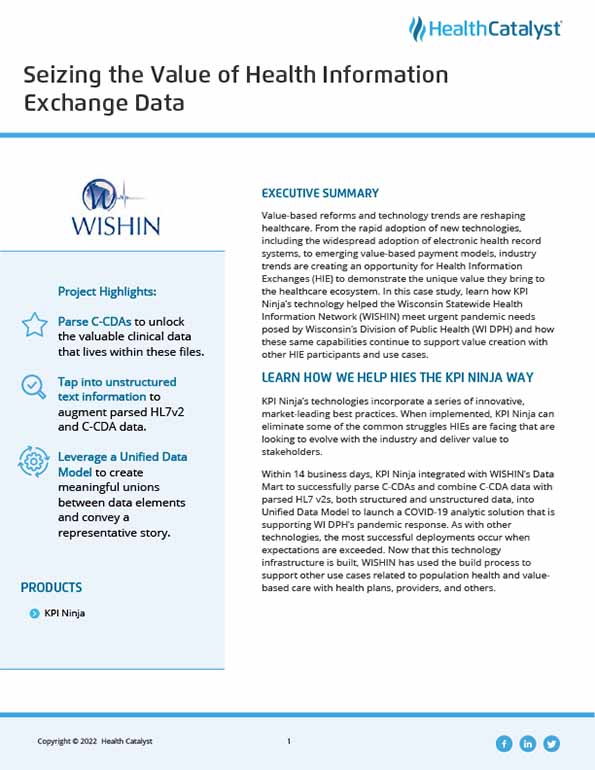Value-based reforms and technology trends are reshaping healthcare. From the rapid adoption of new technologies, including the widespread adoption of electronic health record systems, to emerging value-based payment models, industry trends are creating an opportunity for Health Information Exchanges (HIE) to demonstrate the unique value they bring to the healthcare ecosystem. In this case study, learn how KPI Ninja’s technology helped the Wisconsin Statewide Health Information Network (WISHIN) meet urgent pandemic needs posed by Wisconsin’s Division of Public Health (WI DPH) and how these same capabilities continue to support value creation with other HIE participants and use cases.
KPI Ninja’s technologies incorporate a series of innovative, market-leading best practices. When implemented, KPI Ninja can eliminate some of the common struggles HIEs are facing that are looking to evolve with the industry and deliver value to stakeholders.
Within 14 business days, KPI Ninja integrated with WISHIN’s Data Mart to successfully parse C-CDAs and combine C-CDA data with parsed HL7 v2s, both structured and unstructured data, into Unified Data Model to launch a COVID-19 analytic solution that is supporting WI DPH’s pandemic response. As with other technologies, the most successful deployments occur when expectations are exceeded. Now that this technology infrastructure is built, WISHIN has used the build process to support other use cases related to population health and value-based care with health plans, providers, and others.
Simply put, a Consolidated Clinical Document Architecture (C-CDA) document is an electronic document formatted in a standardized way regardless of the electronic health record system that produces it. The undoubted value of the C-CDA is the comprehensive clinical information that lives in these files that can supplement HL7 v2 data. To meet WI DPH’s business requirements for developing a COVID-19 solution required a strategy to maximize all data available in WISHIN’s Data Mart, not just HL7 v2 data.
During a current-state analysis, it was found that a comprehensive set of C-CDAs was present but being stored as a Blob. Indeed, if a technology solution could parse and normalize the rich C-CDA data and transform it into a discrete and usable format, surely it would enhance WISHIN’s ability to meet the immediate and long-term use cases being asked of WISHIN. This is exactly what KPI Ninja did and continues to do in real time to fulfill the HIE's distinct value proposition.
At the most basic level of healthcare data, codes and value sets serve as the means to communicate clinical concepts. HIEs looking to support participants’ growing data needs often struggle given the considerable variability found in the standards and the way the data is collected at the bedside and recorded in the electronic health record.
At the onset of this project, WISHIN and KPI Ninja set out using the guidelines of the Centers for Disease Control and Prevention and the World Health Organization for identifying "COVID-like” cases and other industry standards for COVID-positive cases. Specific codes for COVID-19 symptoms, diagnoses, laboratory tests and associated results were extracted. Despite dealing with parsed HL7 v2 and C-CDA data, WISHIN and KPI Ninja quickly learned that pulling data based solely on these codes was not representing the full story. Not everyone had adopted and was using the COVID-19 codes, especially early on, so there was an immediate need to create a strategy to maximize the Data Mart by other means.
Through detailed analysis of WISHIN’s Data Mart, it was discovered that more revealing diagnosis information lived within the problem description but was presented in a text format. A similar situation was occurring within the laboratory data. Not all HL7 v2s and C-CDA data, even parsed, had the relevant LOINC codes. Looking deeper, we found critical information lived within the laboratory test names of the parsed files. With advanced technology and a rigorous data validation process, specific words and phrases were extracted from both the problem description and laboratory test name fields to convey a more accurate and representative story that local authorities could have the most complete clinical data with which to respond to and manage the COVID-19 pandemic.
In general, when you bring together various data sources and formats as HIEs do every day, there is inherent complexity in harmonizing the data to represent phenomena in an accurate way. This complexity is further magnified when you bring in unstructured data, as KPI Ninja did with the text data from the parsed files.
For this advanced work, KPI Ninja leveraged its Unified Data Model, a proprietary data information model that maximizes the overarching data architecture of technology, data types and attributes to meet strategic objectives. As one of the most comprehensive, interoperable platforms on the market serving stakeholders throughout the ecosystem, KPI Ninja time and again has proven the extensibility and value of their Unified Data Model.
"Pandemic or not, healthcare organizations need real-time, comprehensive information to drive positive health outcomes. The combination of our strong client relationships and comprehensive data set with KPI Ninja’s advanced technologies help assure that customers feel the value of the health information exchange infrastructure. We do the heavy lifting from a technical end so that our participants can use clinical insights to decrease inefficiencies while upholding the highest quality of care."
- Steve Rottmann, COO, WISHIN
As healthcare scales technology solutions and health data ecosystems become more complex, HIEs need innovative technologies to be at the vanguard of these transformations to position for long-term sustainability. While this report details an innovative technology approach to meet these needs, it is intended to serve as a demonstration piece to convey the tremendous value HIEs have within the healthcare ecosystem to be the solution to enabling population health when technical capabilities are aligned to the needs.




